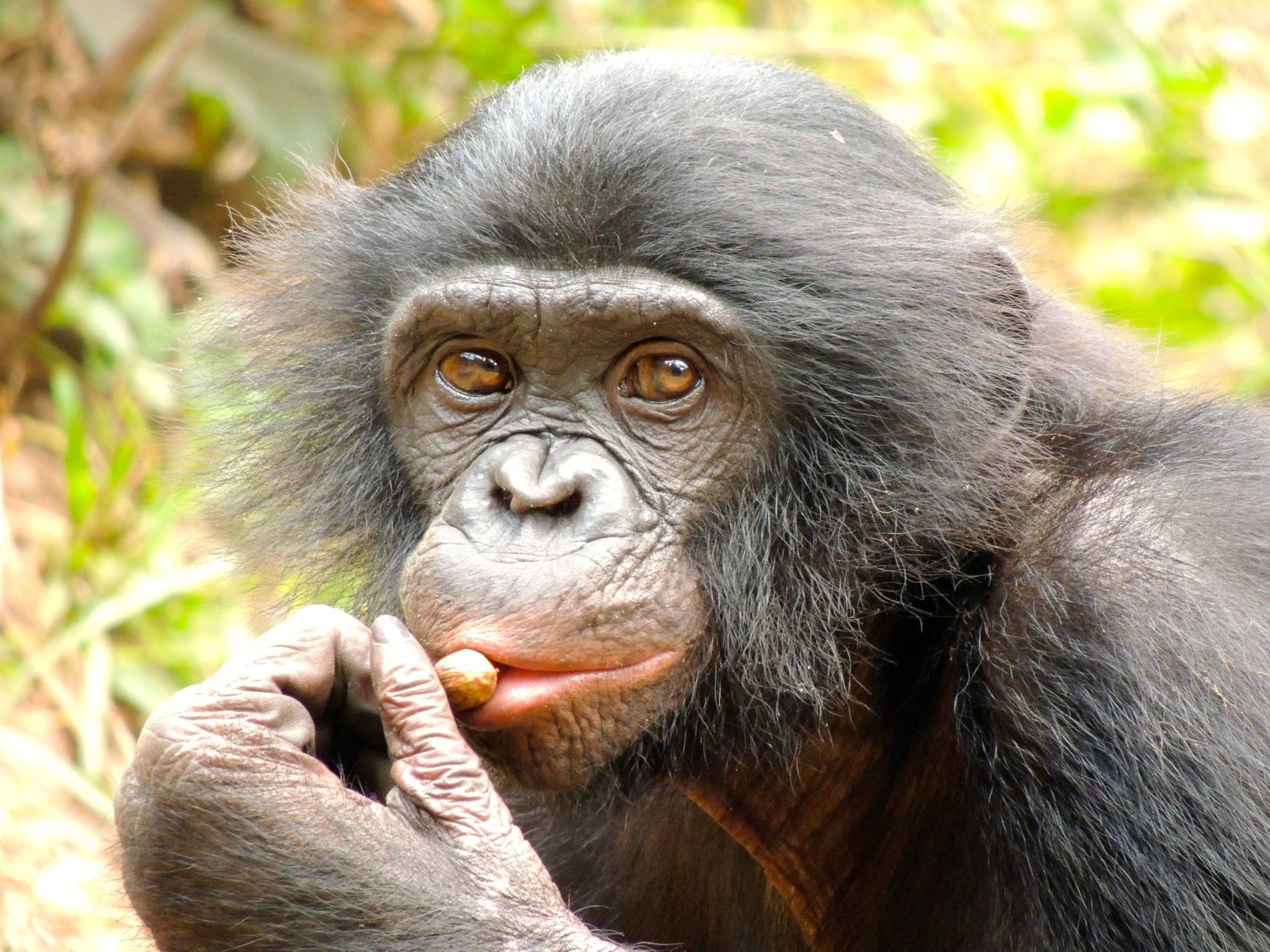In the Congo, a reflection of ourselves: NKU Professor to research Bonobos in May
January 25, 2017
A female chimpanzee, Fitzgerald, extended her arm into the air, exposing her side. The gesture was for her twin boys, beckoning them to cling to her before she was about travel.
The majority of chimpanzees don’t conceive twins. When they do, they often don’t survive. The smaller of Fitzgerald’s offspring, who eventually passed away, immediately came to her and clung. The larger, more independent of the twins ignored his mother.
From afar, Monica Wakefield, an NKU biological anthropology professor, observed the behavior. She studied chimpanzees, particularly social relationships among female chimps, in Uganda for her dissertation research.
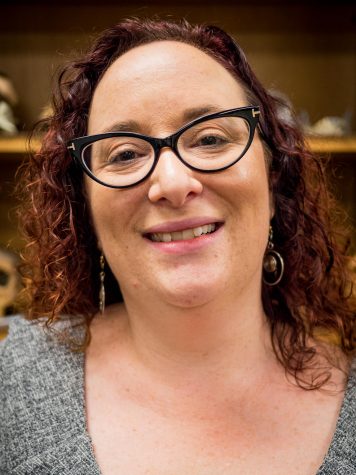
Wakefield works as an anthropology professor at NKU. This summer, along with three research assistants, she’ll go to the Democratic Republic of the Congo to study bonobos.
Fitzgerald continued to gesture toward her son. Eventually, according to Wakefield, she did the thing all mothers have done when their child refuses to come along.
“[She] grabbed the one infant and said ‘Okay! Bye, I’m leaving.’ She was walking away and looking over her shoulder to see if he’d call her bluff and come,” Wakefield laughed. “She kept trying to do that. Finally, she went over and yanked him by the foot and left.”
This struggle is parallel to the behavior of many mothers with their own children. It’s hard not to see ourselves reflected in them, Wakefield said.
This summer Wakefield will continue her research of primates as well as social relationships among females. The research will focus on bonobos, a close relative to the common chimpanzee, in the Democratic Republic of the Congo.
She’ll go along with three research assistants: Ian Takaoka, a recent archaeology NKU graduate, Alex Hickmott, who went to the site with Wakefield in 2014, and Colin Brand, a graduate of Miami University who has worked with DNA data and analysis.
Studying primates: A lifelong dream
As a child, her mother called her ‘monkey.’ Wakefield’s mother encouraged her interest in primates from a young age; working with chimpanzees, gorillas and bonobos is something that Wakefield has always wanted to do.
When she was young, and her family bought their first VHS player, her mother brought home a copy of National Geographic’s special on primatologist Jane Goodall.
Though Wakefield gravitated more toward scientific research, Goodall’s advocacy and conservation efforts were and are an inspiration to her.
Her mother, who passed away 11 years ago, fostered this childhood dream and encouraged Wakefield to pursue it.
“My mom felt as if I was living the life she would have liked to live if she had been born in a different era,” Wakefield said. “She has always supported me in all my trips and travels.”
This passion for anthropology has translated to Wakefield’s students. Lindsey Meador, who has worked alongside Wakefield as a student, teaching assistant, independent study and on the field said in an email that she inspired her to pursue the major.
Currently working as a volunteer research assistant with the Kalahari Meerkat Project in the Kuruman River Reserve, South Africa, Meador said that Wakefield encouraged her to be independent and pursue her passions.
“I had struggled during my first year at NKU to find something that I was exceptional at and wanted to do for the rest of my life,” Meador said. “I definitely found that in Monica’s classroom. “
Meador said that Wakefield is primarily interested in female social relationships in chimpanzees and bonobos while her own work is more focused on male behavior in regards to infants. Ultimately, she finds both friendship and mentorship through Wakefield.
“I always joke that she produced a student who wants to study the opposite sex, but she doesn’t care, and is glad that I have found my own work to be interested in,” Meador said in the email. “She doesn’t want me to be interested in the same thing as her because she knows that is not what will make me a great researcher and an independent mind.”
Wakefield grew up in Alaska, which aided her later in field research, as she spent lengths of time without internet connection.
Her father was a homesteader who went off the grid for some time. She spent months without electricity or plumbing. Her parents divorced when she was young, and though ultimately supportive, her father has always been more hesitant about Wakefield’s excursions.
“He doesn’t like it. He knows better to know that he has any say in it,” Wakefield said. “I called to tell him I got the grant and it was just hysterical. The process of him realizing what it meant. ‘Congratulations! I’m so proud of you! Wait. Does this mean you’re going to Congo? Wait, not congratulations this isn’t good.’ But, he still supports me.”
When she was in Connecticut, studying for her doctorate in biological anthropology at Yale University, her mother would ask her to tell her exactly when she left to travel to see her uncle, who lived four hours away, and exactly when she arrived.
The Congo? No problem.
Beans, rice and life unplugged
To get to their campsite in the Democratic Republic of the Congo, they go through a series of flights. First, they fly to Europe, where they change planes. They then fly to the city of Kinshasa, the capital of the Democratic Republic of the Congo, with a few stops in other African countries.
From the city of Kinshasa, they get into a dugout canoe and set forth on the Congo River. Traveling up river, the tributaries become smaller and smaller. Eventually, they’ll stop in the town of Mbandaka and either sleep in a hotel or set up camp. After this, they’ll travel through villages along the river, asking permission to set up camp.
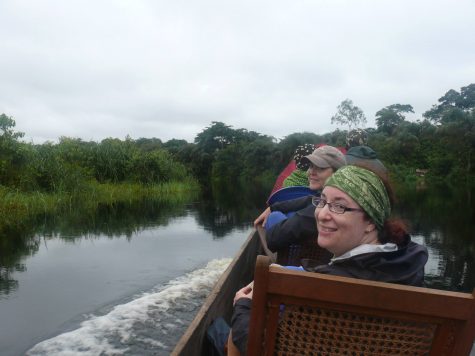
To get their camp site, the team must go through several tributaries. During the 2014 trip, this took four days.
Last time, Wakefield said that they spent four days traveling along the river.
It’s then a nearly 10-mile hike to their campsite.
There’s no electricity at their site, though they have solar panels. Their furniture is made up of materials around the forest and while there they live in huts with thatched roofs.
“We have a small clearing in the forest. It’s a swamp forest so there are a lot of wet, swampy areas where you’re on wet log bridges and things like that,” Wakefield said. “There are other higher areas that are dry with quite often a dense understory where visibility is low. “
Once they get there, it’s a 9-mile hike to the nearest internet connection.
Compared to her first field research experience, fresh from getting her bachelor’s degree and studying African gorillas circa 1998, the hike is a luxury. For a year she was cut off from external communication, aside from being able to receive a little mail.
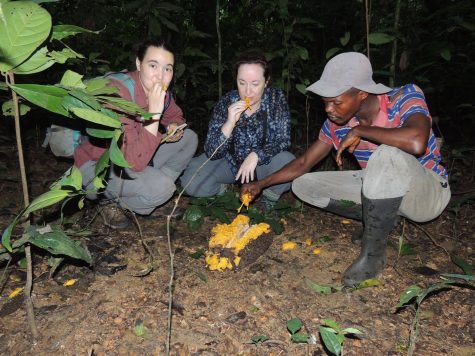
Wakefield and two research assistants snack on fruit in the rain-forest during the 2014 pilot study.
“I actually really love that time to unplug. It’s nice to be able to have more communication with your family, but to not be online all the time—you get a disconnect from your environment when you’re just in camp online all the time,” Wakefield said. “It’s nice just to read and to talk. If you tell people that you can’t check email regularly then they know not to expect a reply.”
Prior to deciding to travel to the Congo, Takaoka faced similar experiences while researching in Fiji in 2015. Motioning to his cell phone and flipping his thumb up in a scrolling motion, Takaoka said that initially being without his phone was the hardest part.
There were days when he realized that he couldn’t go to his phone for answers or entertainment.
Eventually, he found that the process became cathartic.
“Coming back, I thought, was harder than going in,’ Takaoka said. “You develop your own pace when you’re out there and you come back and you’re thrust back into what life around here is like. It’s hectic and schedules are back.”
Reverse culture shock occurs when they travel back home, Wakefield said.
Growing up in a Japanese family Takaoka said his diet wasn’t vastly different. In the camp, they eat fish, rice and beans almost every day.
A vegetarian, Wakefield eats rice and beans during her time in the field.
The research
Last month, Wakefield received the Leakey Foundation Grant, which is dedicated to funding human origins research. Wakefield applied and was granted $6,000 for a summer fellowship salary and a $6,000 summer project grant, which covers the majority of Takaoka’s expenses.
“Bonobos are very understudied relative to chimpanzees, mostly because of how remote they are,” Wakefield said. “They can only be found in the wild in the Democratic Republic of the Congo in very remote areas of the forest that are hard to get to.”
In 2014, Wakefield got enough money from NKU to go the Congo for a pilot study at the site they’re going to return to in May.
Before this, no one had been to the site since 2011. While there, the team collected fecal samples to extract DNA, hormones and isotope data on plants. From this, they can gather more information about the bonobo’s diet. In 2014, they collected enough data to start applying for other grants to return this summer.
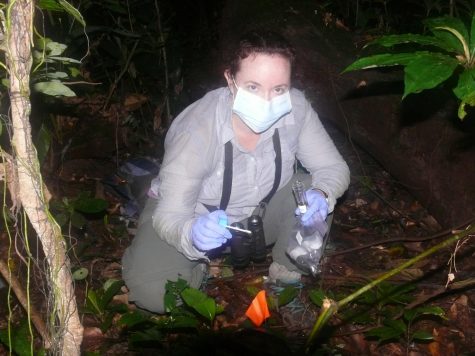
The DNA side of the work is a hefty expense, according to Wakefield.
Habituation will be a large focus on this expedition as well. This means that the presence of researchers become common enough that they are able to accurately observe the bonobos acting out their natural behaviors.
Currently, the bonobos are semi-habituated. Wakefield said that they could watch them in the trees, but once they hit the ground they’d be stirred by the researchers’ presence.
“We need to get them further habituated before I can start answering the questions I’m interested in,” Wakefield said. “In the meantime, we’re doing more genetic analysis.”
Through one sample of fecal matter, they try to gather as much data and information as they can to learn more about the bonobos. According to Wakefield, the researchers are able to garner individual IDs through the DNA, information about their population structure, how many individuals are around, whose associated with who and their conservation status.
“It can take a really long time, and presumably individuals who like one another tend to be found together more than individuals who don’t,” Wakefield said. “It can take a long time observing before you have enough data to be able to elucidate those relationships.”
The bonobos function in a fission-fusion population structure, which means that the social group changes and moves as time passes.
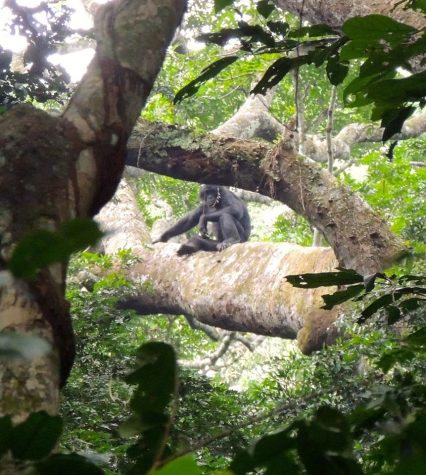
A male bonobo hangs out in the trees. Taken during the 2014 trip, this summer the team will work on habituating the population.
Takaoka comes from an archaeological standpoint. Going in, he’ll be the first person to collect census data on not only the bonobos but other primates and monkeys as well since the 1990s, before the outbreak of the Congo civil war.
The war, which has been going on for 30-plus years, forced scientists to leave the country. As an effect, the combination of increased poaching and pressure from the war caused populations of wildlife to dwindle.
“It’ll be interesting to see if those numbers have started to recover,” Takaoka said. “[As well as] seeing what the human impact of that is.”
To collect this data, he will utilize a Geographic Information System or GIS. According to Takaoka, GIS is widely used to collect and analyze data by archeologists and anthropologists alike.
A mirror into ourselves
Wakefield spent two years of research with the same group of chimpanzees while in Uganda.
At dinner, Wakefield said the researchers would discuss what the chimps had done that day; each had their favorite chimps and the ones they didn’t like. They knew them by name and the unique personalities that they possessed.
From an external view, listening in, Wakefield said that one would think the researchers were discussing people or characters in a television show.
“Chimpanzees and bonobos both belong to the genus pan, and they’re each other’s closest living relatives. We shared a last common ancestor approximately 6 million years ago or so and we do see ourselves in them,” Wakefield said. “I think this is why people tend to have a connection with them.
“You look in their eyes and you see ourselves reflected back. You see a lot of behaviors that you can relate to what you see in humans.”
Despite this inevitable bond, Wakefield said that, as a scientist, one has to keep their distance. Otherwise, they could potentially skew valuable data.
She gave the example of a stranger community meeting with the group being studied. If the two groups are fighting, all the researcher would have to do is make their presence known and the unhabituated group will lose.
This interference skews their natural behavior, which is something a researcher would not want to intentionally do, Wakefield said.
“Sometimes I don’t know if I’m more upset that a chimp has died or that it messes up my data. As a scientist, you still have that side of it,” Wakefield said. “When you watch them in a fight part of you might be concerned about them getting hurt, but you’re also really fascinated with what’s going on and trying to collect data.”
As researchers, it’s easy to attribute human qualities to the subjects they study. According to Wakefield, the root of this research exists in finding the similarities and differences between humans and the primates. She searches for how deeply rooted those attributes are in human’s evolutionary past.
“It’s really hard not to see ourselves in them,” Wakefield said.

